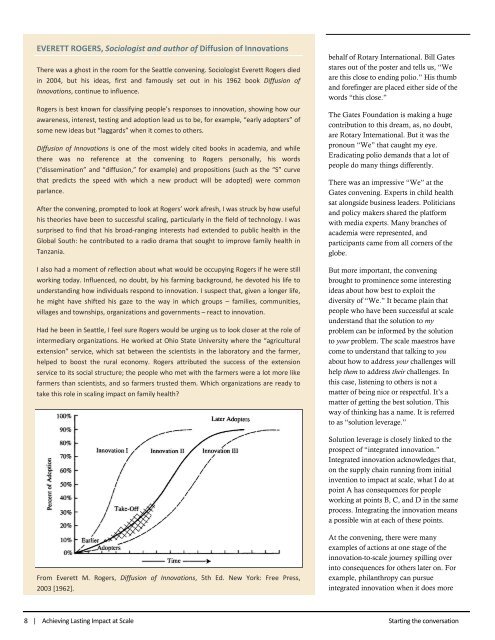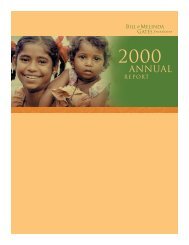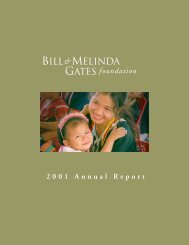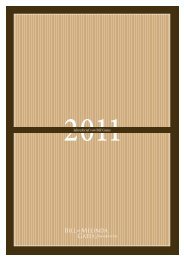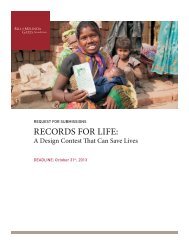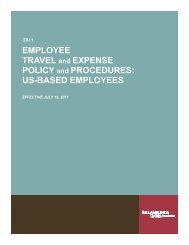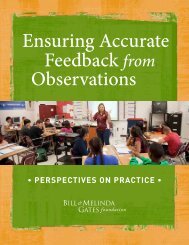Achieving Lasting Impact at Scale - Bill & Melinda Gates Foundation
Achieving Lasting Impact at Scale - Bill & Melinda Gates Foundation
Achieving Lasting Impact at Scale - Bill & Melinda Gates Foundation
Create successful ePaper yourself
Turn your PDF publications into a flip-book with our unique Google optimized e-Paper software.
8<br />
EVERETT ROGERS, Sociologist and author of Diffusion of Innov<strong>at</strong>ions<br />
There was a ghost in the room for the Se<strong>at</strong>tle convening. Sociologist Everett Rogers died<br />
in 2004, but his ideas, first and famously set out in his 1962 book Diffusion of<br />
Innov<strong>at</strong>ions, continue to influence.<br />
Rogers is best known for classifying people’s responses to innov<strong>at</strong>ion, showing how our<br />
awareness, interest, testing and adoption lead us to be, for example, “early adopters” of<br />
some new ideas but “laggards” when it comes to others.<br />
Diffusion of Innov<strong>at</strong>ions is one of the most widely cited books in academia, and while<br />
there was no reference <strong>at</strong> the convening to Rogers personally, his words<br />
(“dissemin<strong>at</strong>ion” and “diffusion,” for example) and propositions (such as the “S” curve<br />
th<strong>at</strong> predicts the speed with which a new product will be adopted) were common<br />
parlance.<br />
After the convening, prompted to look <strong>at</strong> Rogers’ work afresh, I was struck by how useful<br />
his theories have been to successful scaling, particularly in the field of technology. I was<br />
surprised to find th<strong>at</strong> his broad‐ranging interests had extended to public health in the<br />
Global South: he contributed to a radio drama th<strong>at</strong> sought to improve family health in<br />
Tanzania.<br />
I also had a moment of reflection about wh<strong>at</strong> would be occupying Rogers if he were still<br />
working today. Influenced, no doubt, by his farming background, he devoted his life to<br />
understanding how individuals respond to innov<strong>at</strong>ion. I suspect th<strong>at</strong>, given a longer life,<br />
he might have shifted his gaze to the way in which groups – families, communities,<br />
villages and townships, organiz<strong>at</strong>ions and governments – react to innov<strong>at</strong>ion.<br />
Had he been in Se<strong>at</strong>tle, I feel sure Rogers would be urging us to look closer <strong>at</strong> the role of<br />
intermediary organiz<strong>at</strong>ions. He worked <strong>at</strong> Ohio St<strong>at</strong>e University where the “agricultural<br />
extension” service, which s<strong>at</strong> between the scientists in the labor<strong>at</strong>ory and the farmer,<br />
helped to boost the rural economy. Rogers <strong>at</strong>tributed the success of the extension<br />
service to its social structure; the people who met with the farmers were a lot more like<br />
farmers than scientists, and so farmers trusted them. Which organiz<strong>at</strong>ions are ready to<br />
take this role in scaling impact on family health?<br />
From Everett M. Rogers, Diffusion of Innov<strong>at</strong>ions, 5th Ed. New York: Free Press,<br />
2003 [1962].<br />
| <strong>Achieving</strong> <strong>Lasting</strong> <strong>Impact</strong> <strong>at</strong> <strong>Scale</strong><br />
behalf of Rotary Intern<strong>at</strong>ional. <strong>Bill</strong> G<strong>at</strong>es<br />
stares out of the poster and tells us, “We<br />
are this close to ending polio.” His thumb<br />
and forefinger are placed either side of the<br />
words “this close.”<br />
The G<strong>at</strong>es Found<strong>at</strong>ion is making a huge<br />
contribution to this dream, as, no doubt,<br />
are Rotary Intern<strong>at</strong>ional. But it was the<br />
pronoun “We” th<strong>at</strong> caught my eye.<br />
Eradic<strong>at</strong>ing polio demands th<strong>at</strong> a lot of<br />
people do many things differently.<br />
There was an impressive “We” <strong>at</strong> the<br />
G<strong>at</strong>es convening. Experts in child health<br />
s<strong>at</strong> alongside business leaders. Politicians<br />
and policy makers shared the pl<strong>at</strong>form<br />
with media experts. Many branches of<br />
academia were represented, and<br />
participants came from all corners of the<br />
globe.<br />
But more important, the convening<br />
brought to prominence some interesting<br />
ideas about how best to exploit the<br />
diversity of “We.” It became plain th<strong>at</strong><br />
people who have been successful <strong>at</strong> scale<br />
understand th<strong>at</strong> the solution to my<br />
problem can be informed by the solution<br />
to your problem. The scale maestros have<br />
come to understand th<strong>at</strong> talking to you<br />
about how to address your challenges will<br />
help them to address their challenges. In<br />
this case, listening to others is not a<br />
m<strong>at</strong>ter of being nice or respectful. It’s a<br />
m<strong>at</strong>ter of getting the best solution. This<br />
way of thinking has a name. It is referred<br />
to as “solution leverage.”<br />
Solution leverage is closely linked to the<br />
prospect of “integr<strong>at</strong>ed innov<strong>at</strong>ion.”<br />
Integr<strong>at</strong>ed innov<strong>at</strong>ion acknowledges th<strong>at</strong>,<br />
on the supply chain running from initial<br />
invention to impact <strong>at</strong> scale, wh<strong>at</strong> I do <strong>at</strong><br />
point A has consequences for people<br />
working <strong>at</strong> points B, C, and D in the same<br />
process. Integr<strong>at</strong>ing the innov<strong>at</strong>ion means<br />
a possible win <strong>at</strong> each of these points.<br />
At the convening, there were many<br />
examples of actions <strong>at</strong> one stage of the<br />
innov<strong>at</strong>ion-to-scale journey spilling over<br />
into consequences for others l<strong>at</strong>er on. For<br />
example, philanthropy can pursue<br />
integr<strong>at</strong>ed innov<strong>at</strong>ion when it does more<br />
Starting the convers<strong>at</strong>ion


